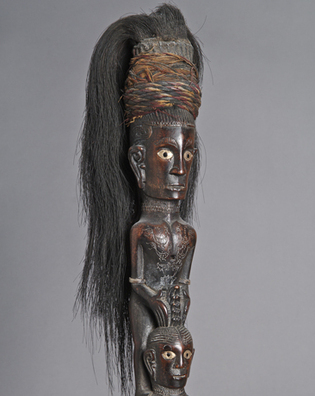 loading
loading
Arts & CultureObject lessonBorn of tragedy, a powerful tool
Ruth Barnes is the Thomas Jaffe Curator of Indo-Pacific Art at the Yale University Art Gallery.
 Johan VipperThis priest's staff from northern Sumatra is topped by a pair of mythical twins. View full image
This story, recorded in a journal of ethnography a hundred years ago, is the origin legend of the priest's staff shown here, from the Batak culture of northern Sumatra. As the story continues, the twins did indeed commit incest and as punishment were fused with the wood of a fruit tree. Their father turned to the most powerful priest alive, who told him that brother and sister had been cursed by the gods and could not be brought back to life. But he also determined that the tree now held supernatural power and could be turned into magic staffs that would strike fear into the hearts of the raja's enemies and prevent drought. The six-foot-high staff, which dates from the mid-nineteenth century, is a promised gift of Thomas Jaffe '71 to the Yale University Art Gallery's new Department of Indo-Pacific Art. It would have been used by a male priest, or datu, a powerful figure in Batak society. The datu determined auspicious days for ceremonies or new endeavors, and he had the power to cast spells, divine the future, influence the weather, find lost objects, diagnose illness, and prescribe medicine. The datu's staff was a symbolic descendant of the legendary fruit tree. He carved it himself from a hard wood that gained patina from repeated ritual anointments with eggs, animal blood, and palm wine. A series of human and animal figures are vertically stacked, with a male figure at top followed by a female—a representation of the twins. The animals include buffalo, horses, elephants, dogs, snakes, lizards, and crocodiles. The entire staff is made from a single piece of wood, and a datu often wrapped the top with cotton thread and cloth, feathers, palm fibers, and hair. The staff was part of the priest's identity and an extension of his magic powers. It was animated with a magical substance inserted into the wrappings at the top and into small holes in some of the figures. Once animated, the staff became an object both to be nurtured and to be feared.
The comment period has expired.
|
|